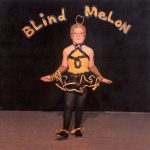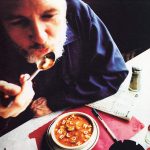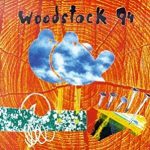You probably remember Blind Melon from their infectious hit song “No Rain”, and the video for the song which featured the “Bee Girl”. This came from their remarkable self-titled debut album, which turned 25 years old last year. After extensive touring, the band followed up with the 1995 album Soup, which replaced the debut’s jam-based sound with a darker, but still compelling vibe. Sadly, Blind Melon’s lead singer Shannon Hoon died shortly after Soup was released from a drug overdose. The music, however, has stayed alive.
This interview with Blind Melon guitarist Christopher Thorn was for a preview article for noozhawk.com for the band’s 9/5/18 show at SLO Brew in San Luis Obispo, and 9/8/18 show at Discovery Ventura. It was done by phone on 8/23/18.
Jeff Moehlis: What can people look forward to at the upcoming concerts?
Christopher Thorn: For the past couple of tours we’ve been digging into some deeper cuts, and mixing it up a lot more to keep ourselves entertained, which then keeps the audience entertained. That’s been fun for us. We’ve really been going through the catalog going, “You know what, we haven’t played that in 20 years. Let’s pull that one out.” That’s been fun for us, and that’s been making the shows exciting.
JM: Are you looking forward to touring the West Coast?
CT: Yeah, it’s been a while. It’s been a while since we’ve done a West Coast run.
JM: I read that a new Blind Melon album is in the works. Can you tell us a bit about that?
CT: Yeah, we’ve been working on that. We’ve done a couple of writing sessions. We did one in Joshua Tree – we wrote some stuff up there – and then we came back in December of last year and cut seven songs here at my studio in Los Angeles. So we’re finishing those up and then we’re going to do another round. I think we’re going to go to Philadelphia where [guitarist] Rogers [Stevens] lives and write a bunch more songs, then we’ll probably do one more session back out either in Joshua Tree or Los Angeles and finish the record. We’re really close. There’s a whole ton of material because we’ve had a bunch of time between records. Everybody has quite a well, so we’ve been going through everything and working the songs out.

JM: It’s hard to believe, but the first Blind Melon album turned 25 last year. Looking back with that perspective, what are your reflections on that particular album?
CT: Oh man, you know, we were so innocent. It was really our first experience making a record, finishing a record, and going through the whole process, the whole set-up, the interviews, the whole thing. It was new to us, so we were pumped and excited. It was a great experience. The band was getting along then, and we had a great time in Seattle when we made that record. Rick Parashar was the record producer on that. We just really loved Rick, and felt like Rick got the best out of us. We made a great record with Rick.
JM: Speaking of Rick, he produced some of the great albums of the 90’s, including the first Blind Melon album. What was he like as a producer?
CT: He was completely hands-off. Rick was as hands-off as they can possibly come. You know, sometimes that can really freak a band out, like, “Why is this guy not around?” But – it took me years to figure out – that’s what a great producer does if the band requires that. That’s what it is. I know Rick wasn’t hands-off on everyone’s record, but he was hands-off on our record because I think he maybe felt that we had a vision, he felt confident that we knew what we were doing and weren’t going to screw things up.
I mean, he came in every day, but he wasn’t in there every day recording with us. We used to laugh about it, because he’d play tennis, and that would go on for a few hours, and around 7:00 or 8:00 he would roll in and listen to what we’d worked on for the day, but then immediately we would start to make plans for the evening of events, which would have nothing to do with recording [laughs]. It was always some other crazy party dinner plan.
But what he was great about, which we really needed, was the communication between our band. He was best at that. He helped the five of us communicate to one another, I would say, great. We looked at him as our Little Buddha. He was fantastic. We couldn’t have made that record without him.
JM: The song “No Rain” was a huge hit for the band. How did that song and the arrangement come together?
CT: That’s a tough one. It was relatively overlooked until we went out there and started touring, and realizing that everyone was singing the words to “No Rain”. I mean, prior to that we knew it was a really good song, but honestly we thought “Change” was going to be the mega-hit. You know, we thought other songs would’ve been the single. So “No Rain” caught us by surprise. It was just a nice, little, simple folk song. It was a great song, and we knocked it out in one day. I don’t remember struggling with it in any way. It was one of the easiest songs that I would say wasn’t necessarily how we normally would go about arranging songs. It was a different song. It was a song that wasn’t developed from a jam, and things like that. A lot of that first record, the songs were developed from jams, so they have a certain freeness about them, a certain interplay between the two guitars. “No Rain” had less of that, and it was just a really great, simple, beautiful song.
JM: Of course the video for that song is quite memorable. What was the origin of the idea for the video, beyond having the “Bee Girl” on the album cover?
CT: Obviously we had the album cover, and we knew that was an iconic image, and all that. But I believe it was Sam Bayer who came in – obviously he had done the Nirvana video and all these big videos – I think that was his call to use the image of the album cover and kind of make her come to life, and tell that story.

JM: The band’s second album Soup is also great, but had a different vibe to it. How was the band’s approach to that album different from how you approached the first one?
CT: I would say completely different. The first record, a lot of the songs, like I said, were developed out of jams with all of us in the room together. We lived together at all times. We literally lived together in North Carolina to write songs to prepare for that first record.
By the second record, we had toured non-stop together for a couple of years, and lived on top of one another and just needed some space. So at that point everybody was writing individually. You know, I can’t talk about other people’s process, I just know my own process for the songs I’d written. I demo’d up all the songs myself – I played the drums and bass and everything – and I would send Shannon a bunch of music, which were finished songs that were musically written, and he would go, “Oh yeah, I wrote lyrics over that one – that’s called ‘Skinned’. I wrote lyrics over that one – that’s called ‘Soup’.” So that’s how my process was.
And then the rest of the guys, we would kind of work them out in the room a bit, but most of them were organized and arranged in a sense before the band got to them. That was a really different process that hadn’t happened on the first record.
JM: In the band’s early years you toured with Guns N’ Roses. What was that experience like?
CT: It was just nuts. We toured with those guys either right when the record came out, or right before when the record came out. No one knew who we were, but because we were opening up for Guns N’ Roses…
One of the first tours was in Mexico – we did Guadalajara, we did two shows in Mexico City, and Monterey, maybe one or two other ones. It was crazy, because we were just a baby band. We had never really played that much, and we were playing literally stadiums. One of the first tours we did was a loop of stadiums down there in Mexico.
We were on the MGM Grand with them, which was like this private plane. It was absolutely bonkers for us to be super-broke kids – we had a record deal, but we had no money – and here we are flying on the MGM Grand, and Guns N’ Roses is up front in their amazing little suites, and we’re in the back with the crew [laughs]. It was crazy. We toured the States with them, and Axl flew in on a helicopter every day. We’d be in our van, finished with our show, trying to get off of the giant premises, but we’d have to wait for Axl to fly in every day. It was just maddening. It was just bizarre. They were the biggest band in the world, and you just knew it as you traveled with them. It was obvious that they were the biggest band in the world.

JM: One of the band’s notable gigs was when you played Woodstock ’94. What are your memories and reflections on that show?
CT: Mostly just being fucking terrified, honestly. Just absolutely terrified. I mean, we had done a million shows by then, but to be put into a situation that you’re following Joe Cocker, the guy that actually was at the real Woodstock – that was kind of crazy, not really the guy you want to follow. You know, the guy that comes out and sings “Feelin’ Alright” [laughs]. Not an easy act to follow.
But I thought Shannon was amazing, and gave a great performance. But it was terrifying. You know, we didn’t get a soundcheck. Nobody did, at least the smaller bands didn’t. And it just was crazy. We flew in on a helicopter just to get to the stage. So the whole day is just filled with absolute craziness. Just the helicopter ride would’ve been enough for me. Then you play a show after that [laughs]. It was surreal, incredible, amazing. It was an amazing, incredible experience that I wish I could go back and be present for, but I think I was out of my body for most of that day, just kind of being overwhelmed.
JM: Do you have a favorite memory of Shannon that you’re willing to share?
CT: For me, my favorite memory is after we had looped the world a few times, and we had time off after the very first record, when we were getting ready to make the second record. Shannon and I went to Mammoth for a couple weeks. I remember the first week we were there we snowboarded all day and wrote songs. I think a few days later Rogers came up, and it was just the three of us. It was just a great time. That’s one of my favorite memories with Shannon because I had him to myself for a bit. It was just me and Rogers and him, and it just was a great time for us to go, “Holy shit! What just happened to us? My God!” You know what I mean? It was like that. It was like, “Did that really just happen to us, all that stuff, or did we just dream that?”
Every day we snowboarded, and every night we came back, made dinner, built a fire, and wrote songs. It was just one of the most amazing experiences. Some of those recordings are on the internet – I think they’re labeled “The Mammoth Sessions”, because I brought in a recording rig. I traveled with – I say “portable”, but it was literally five feet tall, so it was a giant road case that had recording gear in it. So I traveled with that, and I brought that into Mammoth, which is a ski resort in California. It was just a great time. I specifically remember the moment we finished the song “Soup”. I wrote the music, and I think Shannon had three quarters if not more of it finished lyrically and melodically. I just remember finishing the end with him, and it was a really heavy moment. Kurt Cobain had died recently, and we were all affected by that, obviously, and that kind of came out in the end of that song “Soup”. That’s probably one of my favorite memories.
There’s many with Shannon because he kept us entertained quite a bit. I have endless great memories of him.
JM: What advice would you give to an aspiring musician?
CT: In the end, it’s what everybody says. You have to be willing to do it at all costs. That’s really it. There’s a lot of competition out there. You have to work harder than everybody else. You have to be willing to lose more than everybody else. You really have to be dedicated to it. To really make it happen, you don’t just get the job done with one foot it. You really jump in, and you really commit yourself.
And it’s a lifelong thing. It’s not something that you go, “Oh yeah, I did that in my 20’s.” For me, it’s much more spiritual to be a musician and to make records. It’s just deeper for me. So to me, it’s a lifelong mission of how to catch a perfect song out of the universe.
And I just think that you have to stay true to yourself – as cliche and Hallmark card as that sounds, it’s actually true. All this input that you get – “You should be like this”, “You should do this”, “Now be more like this, because that’s what’s happening on radio” – fuck all that. Just stay on your course, and be true to who you are. I think that’s how you make a great career in music. That would be my advice.
And I would also say, it’s a lot easier said than done.
JM: Sometimes I ask people that, and they say, “Quit.”
CT: I would wish my success on everyone who wanted it, because it was an amazing ride for us. I love the music business – it’s been really good to me. But you have to never stop, and you’re at it at all times. To stay in it, you have to be at it at all times. That’s what I know about the music business as well.
JM: You already told us about the new album and the West Coast tour. What else is in the works?
CT: We’ve been working on this Danny Clinch / Shannon Hoon movie, which we’re all really excited about. We’re making really great progress, and we’ve kind of gotten to the next level along with Danny’s help, and there are a couple of other people – Taryn Gould and Colleen Hennessy – who are both also working on the film with us. They’ve all been working hard. So we’re really excited. We’re starting to see some progress. It’s been a slow process, which these things are – documentaries, you know, trying to find funding to finish it, and all that sort of stuff. But we’re really excited about the film. That should be out hopefully this year, but I don’t know that world. I don’t know how to make movies. But we’re excited.
JM: How much is the band involved in that?
CT: Only involved in the sense that we trust Danny enough to make a great documentary about Shannon. And involved in the sense that we see some footage and stuff like that. But we really do trust Danny. We talked about the vision of the film and all that sort of stuff, but this has really been Danny and the people helping on the edits and stuff. So, yeah, we’ve been trusting him.
It’s really all of Shannon’s footage, so if you keep it pure, and you say that we’re mostly going to focus on his footage, it’s an amazing document of Shannon filming himself during the craziness of our career. Filming everything.


Discussion
No comments for “Interview: Christopher Thorn”